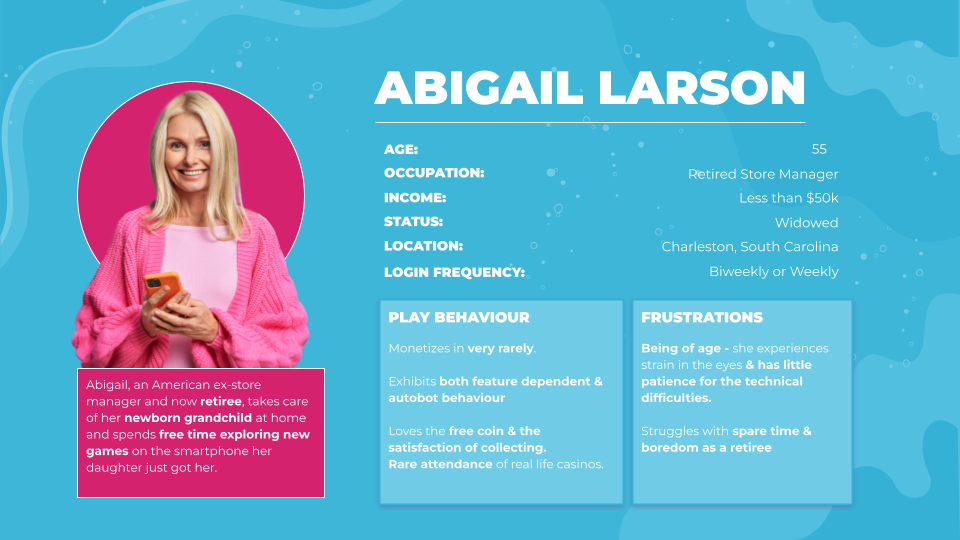Sciplay is known for developing and publishing both mobile and web-based social casino games. They simulate the experience of interacting with casino slot machines as well as virtual versions of poker, blackjack, bingo and more. We were brought on as external consultants for their largest title, Jackpot Party Social Casino and Goldfish.
THE PROBLEM
The Goldfish Slots team bore a similar issue with the Jackpot team, in which they required assessment for existing UX capabilities, ways to implement them with extraneous recommendations, and identify potential blockers to their business as well.
THE GOAL
It always begins with contextualisation. We had to evaluate and recommend, and the best way to start was through user interviews, more specifically in this case, we had to conduct the following:
Note Synthesis
Bagging & Tagging
Issue Analysis (Market Research, Geodata Compilation)
Report, Productise, Educate
Through 14 user interviews, we identified 41 issues in total, and similar to Jackpot’s approach, we analysed localised versus high impact issues and prioritised them accordingly.
THE EVALUATION
We endeavoured to deep dive into the global reaches of the Goldfish product through geodata market research. Surveys were also conducted to get a grasp of some of the pain points casual players were experiencing on the mobile application of the game.
We identified key competitors and countries with the greatest revenue metrics during the 2021 to 2022 period.
We also took the opportunity to identify opportunities in the market judging by the research data, weighing the pros and cons of each country on the map. Japan stood out as one of the key opportunistic areas.
5 different types of players were also identified and their engagement patterns studied. This provided key information about our target market in greater detail in the sense that we had complete insight on how they would predictably interact with the game at any time of the day.
Through this exercise, we had to single out the geography and the player type that we wanted to focus on. This would feed into persona creation later on.
THE RECOMMENDATION
The recommendation phase meant introducing to the team key tools that would revitalise their working experience. This always meant one thing - aligning the team around the exact same objectives, and making sure they were asking the right questions instead of the wrong ones when approaching a project. We conveyed these through an educational deck meant to upskill the team.
PERSONAS
Aligns team around understanding of player and their motives and creates opportunity for alignment of LiveOps, Features, and Strategy.
PRODUCT DESIGN
Approach to work combining super powers to align business and user experience goals. Working in a hypothesis/validate framework mitigates risk and sunk costs.
PRIORITIZATION
Framework for every discipline to offer priorities and circle the wagons around meeting business goals. Leadership can be empowered to set strategy addressing their primary areas of responsibility.
LEAN UCD
Provides a framework to address majority of concerns, reducing friction in pre-production, and improving outcomes in production.
PERSONA DEVELOPMENT & DATA SYNTHESIS
Our final deck consisted of all of the broken down information gathered and analysed from the geodata and engagement pattern research. The educational component of the final deck involved explaining how the recommended tools have to be used in principle and in practice, followed by a demonstrative workshop on how to use personas.
An applied approach to developing personas based on the data we analysed. This is part of the effort to refine population definitions for the target market of the game. The Persona Development Map proved to be the quickest way to developing empathy for the user.
Personas we developed as part of the exercise and to represent the target market.
TAKEAWAYS
It is important to note that users are not just numbers or statistics; they are real individuals with unique backgrounds, abilities, and perspectives. Empathy reminds us to design inclusively, considering diverse user groups and ensuring accessibility for all. By empathizing with different user personas, we can create experiences that resonate with a broader audience. Numbers and statistics give us the power to analyse trends and engagement, but personas enable us to make those findings meaningful.














